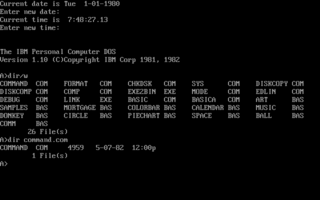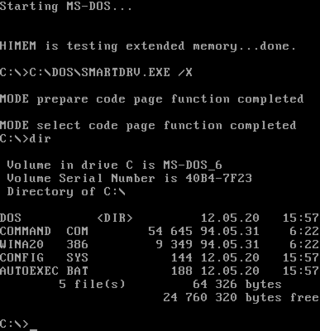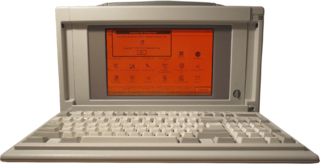
The Tandy 1000 was the first in a series of IBM PC compatible home computers produced by the Tandy Corporation, sold through its Radio Shack and Radio Shack Computer Center stores. Introduced in 1984, the Tandy 1000 line was designed to offer affordable yet capable systems for home computing and education. Tandy-specific features, such as enhanced graphics, sound, and a built-in joystick port, made the computers particularly attractive for home use.

IBM PC DOS, also known as PC DOS or IBM DOS, is a discontinued disk operating system for the IBM Personal Computer, its successors, and IBM PC compatibles. It was sold by IBM from the early 1980s into the 2000s. Developed by Microsoft, it was also sold by that company to the open market as MS-DOS. Both operating systems were identical or almost identical until 1993, when IBM began selling PC DOS 6.1 with its own new features. The collective shorthand for PC DOS and MS-DOS was DOS, which is also the generic term for disk operating system, and is shared with dozens of disk operating systems called DOS.
Kaypro Corporation was an American home and personal computer manufacturer based in Solana Beach in the 1980s. The company was founded by Non-Linear Systems (NLS) to compete with the popular Osborne 1 portable microcomputer. Kaypro produced a line of rugged, "luggable" CP/M-based computers sold with an extensive software bundle which supplanted its competitors and quickly became one of the top-selling personal computer lines of the early 1980s.
NTLDR is the boot loader for all releases of Windows NT operating system from 1993 with the release of Windows NT 3.1 up until Windows XP and Windows Server 2003. From Windows Vista onwards it was replaced by the BOOTMGR bootloader. NTLDR is typically run from the primary storage device, but it can also run from portable storage devices such as a CD-ROM, USB flash drive, or floppy disk. NTLDR can also load a non NT-based operating system given the appropriate boot sector in a file.

fdisk is a command-line utility for disk partitioning. It has been part of DOS, DR FlexOS, IBM OS/2, and early versions of Microsoft Windows, as well as certain ports of FreeBSD, NetBSD, OpenBSD, DragonFly BSD and macOS for compatibility reasons. Windows 2000 and its successors have replaced fdisk with a more advanced tool called diskpart.

DOS Shell is a file manager that debuted in MS-DOS and PC DOS version 4.0, released in June 1988. It was no longer included in MS-DOS version 6, but remained part of the Supplemental Disk. The Supplemental Disk could be ordered or could be downloaded through Microsoft's FTP server. DOS Shell was retained in PC DOS until PC DOS 2000.
A remote access service (RAS) is any combination of hardware and software to enable the remote access tools or information that typically reside on a network of IT devices.

The Atari Portfolio is an IBM PC-compatible palmtop PC, released by Atari Corporation in June 1989. It was the first palmtop computer compatible with the IBM PC ever released.

Microsoft Diagnostics (MSD) was a software tool developed by Microsoft to assist in the diagnostics of 1990s-era computers. Users primarily deployed this tool to provide detailed technical information about the user's software and hardware and to print the gathered information, usually for use by support technicians in troubleshooting and resolving problems. The assumptions made by the program were valid until the late 1990s: it does not handle plug-and-play USB or other new technologies that appeared around 2000.
3+Share, also known simply as 3+ or 3 Plus, was a pioneering file and print sharing product from 3Com. Introduced in the early 1980s, 3+Share was competitive with Novell's NetWare in the network server business throughout the 1980s. It was replaced by the joint Microsoft-3Com LAN Manager in 1990, but 3Com exited the server market in 1991.

Microsoft Drive Optimizer is a utility in Microsoft Windows designed to increase data access speed by rearranging files stored on a disk to occupy contiguous storage locations, a technique called defragmentation. Microsoft Drive Optimizer was first officially shipped with Windows XP.
RM Nimbus was a range of personal computers from British company Research Machines sold from 1985 until the early 1990s, after which the designation Nimbus was discontinued. The first of these computers, the RM Nimbus PC-186, was not IBM PC compatible, but its successors the PC-286 and PC-386 were. RM computers were predominantly sold to schools and colleges in the United Kingdom for use as LAN workstations in classrooms.

MS-DOS is an operating system for x86-based personal computers mostly developed by Microsoft. Collectively, MS-DOS, its rebranding as IBM PC DOS, and a few operating systems attempting to be compatible with MS-DOS, are sometimes referred to as "DOS". MS-DOS was the main operating system for IBM PC compatibles during the 1980s, from which point it was gradually superseded by operating systems offering a graphical user interface (GUI), in various generations of the graphical Microsoft Windows operating system.

DOS is a family of disk-based operating systems for IBM PC compatible computers. The DOS family primarily consists of IBM PC DOS and a rebranded version, Microsoft's MS-DOS, both of which were introduced in 1981. Later compatible systems from other manufacturers include DR-DOS (1988), ROM-DOS (1989), PTS-DOS (1993), and FreeDOS (1994). MS-DOS dominated the IBM PC compatible market between 1981 and 1995.

In computing, net is a command in IBM OS/2, Microsoft Windows, ReactOS and Greentea OS used to manage and configure the operating system from the command-line. It is also part of the IBM PC Network Program for DOS.
'Commodore 64 disk/tape emulation and data transfer' comprises hardware and software for Commodore 64 disk & tape emulation and for data transfer between either the C64 computer, the Commodore 1541 disk drive or Commodore 1530 Datasette tape deck, and newer computers.

The Compaq Portable 386 is a computer released by Compaq Computer Corporation in 1987. It was equipped with a 20 MHz Intel 80386 CPU, 1 MB RAM, 16 KB ROM, 1.2 MB5¼-inch floppy, 40 or 100 MB hard disk drive, priced at US$7,999 or 9,999 respectively, and a 10" amber gas-plasma display.
The command-line tool exe2bin is a post-compilation utility program available on MS-DOS and other operating systems.

Laplink is a proprietary software that was developed by Mark Eppley and sold by Traveling Software. First available in 1983, LapLink was used to synchronize, copy, or move, files between two PCs, in an era before local area networks, using the parallel port and a LapLink cable or serial port and a null modem cable or USB and a USB ad hoc network cable. Traveling Software is now known as LapLink Software, Inc., and their main software is now the PCmover.












